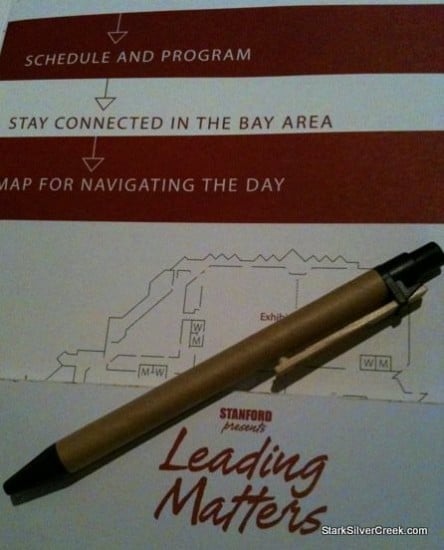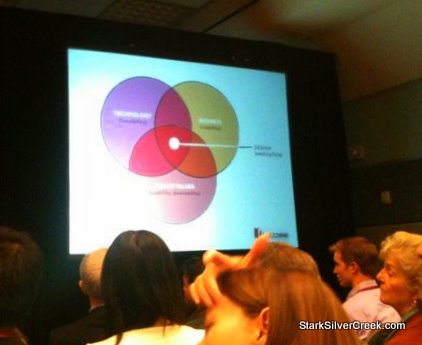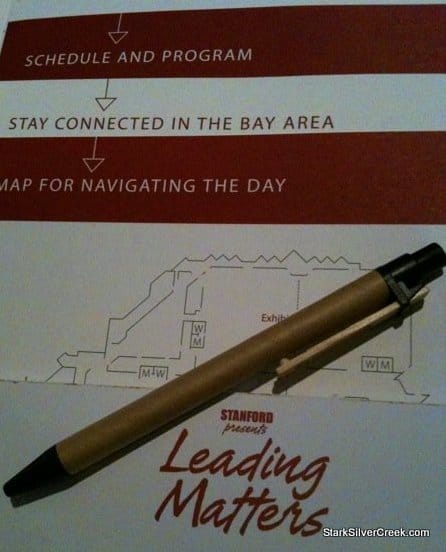
While Clint scurries off to the session on cars, I decide to squeeze into the panel session held by Hasso Plattner Institute of Design at Stanford (more affectionately referred to as Stanford d.school, a play on references to B-school).
The seats fill up fast. Luckily, having to only scout for a single free seat, I was able to find a spot in the third row beside a guy who I find out just a few minutes before the session starts, was in an undergraduate Stanford class that Jerry Yang, now CEO of Yahoo! visited in the early days of the company.
Jerry had come into the class to demo an early version of Yahoo! At the time, the guy noted he thought: How useful can it be? How can you build a business on that idea? It’s just an electronic directory! At the end of the demo, Jerry handed out his business card and the guy took one but had no intention to work for a start-up with such a crazy idea. Little did he know back then what he knows now… Silicon Valley is overflowing with such stories.
The chatter dies down as David Kelley (MS ’78), Donald W. Whittier Professor in Mechanical Engineering and founder of IDEO starts off the session introducing the other three speakers at the front of the room. He starts off with George Kembel, the executive director of Stanford d.school. Instead of reading the written bio in the ‘Leading Matters’ schedule guide, David proceeds to tell us that George has an identical twin John and when he had taught George, he would sometimes get George and John mixed up. Next up is Perry Klebahn, consulting associate professor of Stanford d.school and founder of Atlas Snowshoes, who we find out likes to ride motorcycles so fast that he flipped and flew over a guardrail once and landed on the beach. Finally Diego Rodriguez, consulting associate professor at d.School and partner at IDEO, enjoys racing cars and runs a blog, Metacool. By this time I am seriously contemplating running out of the session and taking up skydiving as a hobby.
The session quickly moves to the topic of innovation and how Stanford d.school is teaching the process and how it in itself is evolving the way teaching and learning happens.
One aspect of innovation is that there must be a free flow of ideas. David notes that d.school strives hard to remove the hierarchy between teacher and students. When you enter a class a d.school, it shouldn’t be apparent who are the teachers and who are the students. Another way to level the authority which constricts creativity is to enable students to create their own spaces and for the faculty to visit students in these spaces to teach.
What I found particularly inspiring is that the panel had a general view that people have an innate desire to innovate and the process methodology is to help develop creative confidence. In Silicon Valley, there is much opportunity to develop the left side of the brain, the right side of the brain though is often under-served. The panel discussed the desire to want to be a creative person, yet many shy away from the notion, having little confidence in one’s ability.
The definition the panel gave of “design innovation” is that it is the intersection of technology (feasibility), business (viability) and human-values (usability/desirability). I thought that was one of the best definitions I have come across. This notion was emphasized by a Venn diagram projected on the screen.

Mixed in with the dialogue on best practices for engendering innovation is a steady promotion of Stanford d.school…and why not? This is a Stanford University event.
Another aspect of innovation the panel emphasize was the need to take risks and to “stop talking and start making”. Get out something early and get rapid feedback to improve it. Invariably, there are design consideration that results from these iterations that would not have if the idea was stuck in Powerpoint and words.
prototype in low resolution: This is a concept of using a simple model to test out a much more complex situation. An example of this is a project the d.school did for JetBlue to test out a new phone queue method the company was considering. The general concept is that they could provide customers with greater satisfaction if they “held” the spot of the caller and instead of making the caller stay on the line, offer to call them up when their turn was up in the queue. The specifics of this idea was through through not by building a new IVR system, but instead, by going to the post office at Stanford University and mimicking the process by study members offering to wait in line for those in the post office lines.
There is also the emphasis of “need-finding” vs. “problem-solving”. The former is to emphasize looking for issues that really need to be solved instead of looking for things that may be problems but would produce little value if solved. An example of this is the Embrace company which started with the quest to find a low cost incubator for newly born babies. The result was a rethinking of the problem to looking for a design which would keep the baby warm. This opened the students’ eyes to a greater scope of possible solutions.
Such a grand topic invites grand questions of course. One could put the questions from the Q&A session into three key categories. There are those that have suggestions of themes the d.school could investigate in a future course. Others want to get opinions from the panel on an actual problem such as how to instill processes for innovation in global governmental bodies to solve world problems…an answer please in 3 minutes or less! And finally, there are those that wanted to find out more on how to get involved whether as students or instructors.
For me, the session is very inspiring and thought-provoking. Being in the midst of re-designing my home office, I thought about the idea of putting all the furniture on wheels so I could move them around. Would this create a better environment for innovation? I know Clint is probably already getting scared of how this session will impact my design of the home office. Another part of me thought about how I could better communicate the idea of citizen-centric government focusing not only on the technology (feasibility) component but also the rest of the components of that Venn diagram that seems to persist on my brain.
People start standing up around me and I realize it is the end of the session. I hurry out to meet Clint to plan our strategy for the next session.


